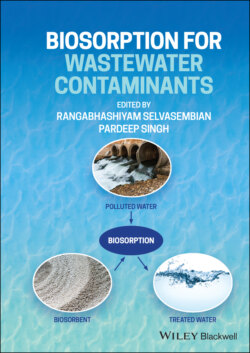Читать книгу Biosorption for Wastewater Contaminants - Группа авторов - Страница 21
Conclusion
ОглавлениеThe primary contaminants found in industrial wastewater have been shown to commonly originate from human activities. Industrial wastes are becoming more recalcitrant, complex, and abundant due to the increasing development of society, and the list of pollutants. This chapter addressed the effects of toxic heavy metals, oil and grease, biocides, dyes, recalcitrant and organic compounds, and contaminants of emerging concern.
Regarding toxic heavy metals, it is important to differentiate between heavy metals and toxic metals. The classification of many elements and compounds is largely based on their density. However, not every heavy element is toxic. With that in mind, copper, lead, chromium, cadmium, zinc, and arsenic are the most important. Bioaccumulation, vomiting, diarrhea, and inflammation are the usual symptoms of toxic heavy metal poisoning. Furthermore, such pollutants negatively impact humans and other species, hindering their reproductivity and metabolism, which unbalances the food chain as a whole.
Chemically speaking, dyes were developed to resist degradation since they have hydrophilic and chromophoric groups that provide color and strong persistence in aqueous phases. The primary consumer of dyes is the textile industry, which generates millions of dollars annually worldwide. Other sectors are also important in this context, such as the paper, tannery, food, pharmaceutical, and cosmetic industries. It must be noted that natural‐based dyes are not the focus of this discussion since they are much more biodegradable than synthetic dyes and are less frequently used.
Oil and grease have always been one of the primary human contaminants in wastewaters. However, society is and will continue to be strongly dependent on petroleum and its derivatives. Thus, oil and grease from this industry will continue to be a significant threat to natural ecosystems. Fortunately, many methods are known to reduce their concentration in industrial waters.
Taking into account population growth, the need for food has significantly increased. To supply demand, the manufacturing and application of biocides have become increasingly necessary to guarantee crops and preserve them against stronger adverse agents (insects and other organisms). Such chemicals are made to be recalcitrant and toxic. Thus, they need to be properly removed from agricultural and industrial wastewaters so they do not affect human health through food.
Human activities have increased the consumption of organic and recalcitrant compounds such as phenols, VOCs, DDT, PCHs, PAHs, PCBs, POPs, etc., but these substances are proven to be carcinogenic, teratogenic, and mutagenic, besides being persistent in the environment. Commonly, industrial wastewater containing recalcitrant compounds contains other toxic materials that may affect biological treatment, given that advanced oxidation processes have been addressed and shown more suitable results.
Considering a more recent approach, contaminants of emerging concern must be highlighted. Even at small levels, they have shown harmful effects in humans and are capable of disrupting the endocrine system and causing other, as‐yet‐unknown impacts. Such pollutants are persistent in the environment and result from human activities. Hence, the list of these compounds is constantly growing and must be studied in depth.
The industrial sector has to acknowledge the impacts and complexity of its contaminants for humans and the environment. Therefore, suitable treatment methodologies must be developed and addressed. Once such understanding is adopted worldwide, hazardous impacts from these activities will not be a threat but instead can be properly controlled and made harmless.
